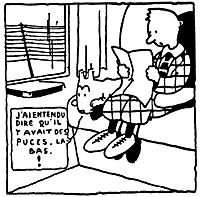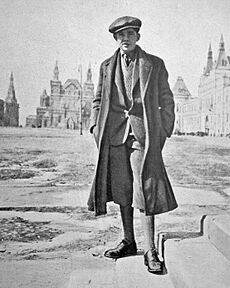Tintin (character) facts for kids
Quick facts for kids Tintin |
|
|---|---|

Tintin and his dog Snowy in a panel of Tintin in the Land of the Soviets, their first appearance, by Hergé
|
|
| Publication information | |
| Publisher | Casterman (Belgium) |
| First appearance | Tintin in the Land of the Soviets (1929) |
| Created by | Hergé |
| In-story information | |
| Species | Human |
| Partnerships | List of main characters |
Tintin is the main hero of The Adventures of Tintin, a famous comic series created by Belgian cartoonist Hergé. The character first appeared in 1929 in a Belgian newspaper's youth section. Tintin is a young, smart reporter with a unique hairstyle called a quiff. He travels all over the world with his loyal dog, Snowy.
Tintin has been a very popular character for many years. You can find statues and murals of him in Belgium. Besides the comics, Tintin has also appeared in plays, radio shows, TV shows, and movies. One famous movie is The Adventures of Tintin (2011), directed by Steven Spielberg.
As of January 1, 2025, the earliest Tintin comics from 1929 became available for everyone to use freely in the United States. This means they are in the public domain there. However, Tintin's works are still protected by copyright in Belgium and many other countries.
Contents
The Story Behind Tintin
Who Inspired Tintin?
Hergé, the creator, was influenced by many things when he made Tintin. When he was young, during World War I, Hergé drew pictures of a brave young man fighting enemies. He said these drawings showed a smart and adventurous character.
Hergé's younger brother, Paul, also inspired Tintin's look. Paul had a round face and a quiff, just like Tintin. Hergé watched his brother a lot and found his movements and presence inspiring.
Before Tintin, Hergé drew a Boy Scout character named Totor for a magazine. Totor traveled the world and helped people. Hergé later said Tintin was like Totor's "little brother," keeping the same adventurous spirit.
Other stories and people also played a part. There was an old illustrated story from 1898 called Tintin the Goblin with a similar-looking character. Hergé also knew about famous journalists like Albert Londres, who traveled and investigated stories. A 15-year-old Danish Boy Scout named Palle Huld traveled around the world in 1928 and wrote about it. This trip almost certainly influenced Hergé.
Hergé was also interested in the new style of American comics with speech bubbles. He wanted to create a comic strip where drawings told the story. Tintin became a mix of these inspirations: a traveling reporter with a strong moral compass.
How Tintin Began
Tintin first appeared after Hergé started working at a Catholic newspaper. His boss asked him to create a new comic series for a youth section called Le Petit Vingtième. On January 4, 1929, an advertisement for Tintin and Snowy appeared. Hergé later said Tintin was truly "born" on January 10, 1929, with the first episode of Tintin in the Land of the Soviets.
Hergé didn't take Tintin very seriously at first. He saw him as a "joke between friends." Early Tintin stories were very "Belgian," reflecting the ideas of a young Belgian Catholic. Tintin was seen as a simple character, mostly there to move the story forward. He didn't have a last name or a family, and his job wasn't always clear.
About Tintin's Character
What Tintin Looks Like
Tintin's look is very famous: a young man with a round face and a white fox terrier running beside him. Hergé created Tintin as a young, blonde Belgian from Brussels. He represents traditional values.
In his first appearance, Tintin wore a long coat and hat. Soon after, he started wearing his famous plus fours (short trousers), a checked suit, and his quiff hairstyle. Once his quiff popped up during a car chase, it stayed that way! Tintin's look didn't change much over the years. Hergé said Tintin "practically did not evolve" in how he looked.
Hergé never explained why he chose the name "Tintin." He said it had no special meaning. Some people think it might be his last name because others sometimes call him "Mr. Tintin." But Hergé said it couldn't be his last name because he has no family. He probably chose it because it sounded "heroic, clear, and cheerful."
Tintin's age is never clearly stated. He stays young throughout all his adventures, which were published over 50 years. Hergé once said he thought Tintin was about 14 or 15 when he created him, like a Boy Scout. He joked that Tintin might have aged only 3 or 4 years in 40 years of stories.
What Tintin Does
From his very first adventure, Tintin is a reporter. He travels to places like the Soviet Union and the Belgian Congo, sending back stories and photos. In The Blue Lotus, a newspaper even features "Tintin's Own Story." He often carries a notebook and asks questions, like a true journalist.
However, as the stories go on, Tintin acts more like a detective. He uses his sharp mind and eye for detail to solve mysteries. People sometimes compare him to Sherlock Holmes. He's good at disguises and even has a main enemy, Rastapopoulos.
Later, Tintin's job changes even more. He becomes an explorer, not just a reporter. He doesn't seem to worry about money. After Red Rackham's Treasure, he lives at Marlinspike Hall with Captain Haddock and Professor Calculus. He explores the sea, mountains, and even the Moon (long before real astronauts like Neil Armstrong and Buzz Aldrin went there!). Throughout it all, Tintin is a hero who stands up for those who need help.
Tintin's Special Skills
Tintin is very good at many things. He can drive or fix almost any vehicle, from cars to a moon tank. He's also great with airplanes. He knows Morse code and is a skilled radio operator. When needed, he can throw a strong punch, swim well, and is an excellent shot. He's also a good engineer and scientist, especially during his trip to the Moon. Tintin is a strong athlete, able to walk, run, and swim long distances.
Hergé described Tintin as "a hero without fear and beyond reproach." Most importantly, Tintin is a quick thinker and good at solving problems peacefully. He's an all-around talented person, good at almost everything.
Tintin's Personality
Tintin's personality changed a bit over time. In the early stories, he was sometimes silly and sometimes very smart. He was very good and brave, always helping the weak. He never looked for trouble but always found it!
Tintin is an honest, kind, and caring young man. He's also humble and a very loyal friend. He does have a few flaws, like getting a bit too tipsy once or too angry another time. But he has a "tremendous spirit." In Tintin in Tibet, he is even given the name "Great Heart."
Tintin can be innocent, a fighter for justice, an adventurer, and sometimes a bit cynical. Hergé said that even if Tintin is a moral person, he doesn't take things too seriously. There's always humor in his stories, which is why people all over the world love him.
Tintin in Movies and Shows
Tintin has appeared in many real-life events and adaptations. The first time someone played Tintin in real life was on May 8, 1930, at a train station in Brussels. A 15-year-old boy dressed as Tintin and was met by a huge crowd of fans!
Tintin has also been in plays. The first actress to play Tintin on stage was Jane Rubens in 1941. Later, a young boy named Roland Ravez took over the role and also voiced Tintin in radio recordings.
Two live-action movies featured Tintin: Tintin and the Golden Fleece (1961) and Tintin and the Blue Oranges (1964), both starring Jean-Pierre Talbot as Tintin.
In 1991, a Canadian animated TV series called The Adventures of Tintin was made. Colin O'Meara voiced Tintin in this series. Around the same time, the BBC created a radio drama series where Richard Pearce was the voice of Tintin. In 2005, Russell Tovey played Tintin in a play in London.
Hergé admired director Steven Spielberg and felt he was the only one who could bring Tintin to the big screen. This led to the 2011 movie The Adventures of Tintin, which combined stories from three Tintin books.
Tintin Movies and TV Shows
- Live-action Movies
- 1961: Tintin and the Golden Fleece
- 1964: Tintin and the Blue Oranges
- Animated Films
- 1947: The Crab with the Golden Claws
- 1964: The Calculus Case
- 1969: Tintin et la SGM
- 1969: Tintin and the Temple of the Sun
- 1972: Tintin and the Lake of Sharks
- 2011: The Adventures of Tintin
- Television Series
- 1957–1961: Hergé's Adventures of Tintin (animated series)
- 1992: The Adventures of Tintin (animated series with 3 seasons)
See also
 In Spanish: Tintín (Las aventuras de Tintín) para niños
In Spanish: Tintín (Las aventuras de Tintín) para niños
- List of The Adventures of Tintin characters




